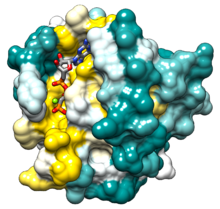Structural Biochemistry/Cell Signaling Pathways/RAS
Ras proteins are a family of genes involving cellular signal transduction as one of its many functions. They are binary molecular switches that control intracellular signaling networks. However, they can also exert control over processes such as actin cytoskeletal integrity, proliferation, differentiation, cell adhesion, apoptosis, and cell migration. These signals also affect cell growth, differentiation, and cell survival.
The signals are sent from outside the cell to the nucleus. Mutations in RAS genes can cause inappropriate transmission inside the cell in the absence of extracellular signals.

Workings of Ras
editRas is a guanosine-nucleotide-binding protein with 6 beta sheets and 5 alpha helices. Ras binds to a magnesium ion to help coordinate nucleotide binding. In other words, it is a G-protein, where the G comes from the guanosine in the protein. G proteins function have “on” and “off” states, and as might be expected they have different functions and properties in these two different states.
Off state: In the "off" state Ras is bound to the nucleotide guanosine diphosphate (GDP).
On state: In the "on" state, Ras is bound to guanosine triphosphate, (GTP). There is the obvious difference that GTP contains one more phosphoryl group than GDP, which can be ascertained from the name itself.
The extra phosphate in the “on” state is very important because it holds the two switch regions in a specific configuration. When released from this configuration, the switch regions relax – this causes a change in the conformation which leads to the activate state. It becomes clear that the activation and the deactivation of the Ras is controlled by the properties of GTP and DTP. However, Ras can be separated from GDP but only with the use of GEFs. The balance between GEF and GAP activity determines the guanine nucleotide status of Ras, thereby regulating Ras activity. In the GTP-bound conformation, Ras has high affinity for numerous effectors that allow it to carry out its functions. Ras can attach to the membranes of the cells in our body, and this is very important because this binding is responsible for many pathways which couple growth factor receptors to downstream mitogenic effectors involved in cell proliferation or differentiation.
History of Ras
editFirst identified by Edward M. Scolnick and his team at the National Institutes of Health (NIH) as transforming ocogenes responsible for the cancer-causing activities of the Harvey (HRAS oncogene) and Kirsten (KRAS) sarcoma viruses, Ras genes were originally discovered in rats during the 1960s. Therefore the name Rat sarcoma was formed. In 1982 Geoffry M. Cooper at Harvard, Mariano Barbacid and Stuart A. Aaronson at the NIH and Robert Weinberg of MIT discovered transforming and activated human RAS genes in human cancer cells.
A third human RAS gene known as NRAS was discovered later on. It is named NRAS for its initial identification in human neuroblastoma cells.
All three human RAS genes have 188-189 amino acid proteins designated as H-Ras, N-Ras, and K-Ras4a and K-Ras4B. K-Ras4a and K-Ras4B arise from alternative gene splicing.
Ras in cancer
editRAS affects cell growth and division. Therefore, cancer and oncogenesis can arise. Activating mutations are found in 20-25% of all human tumors and up to 90% in specific tumor types.
Cancer causing genes are called oncogenes.And that of the normal cellular genes are called proto-oncogenes.A proto=oncogene becomes an oncogene when a genetic change that leads to an increase either in the amount of the proto-oncogene's protein product or in the intrinsic activity of each protein molecule. The genetic changes that convert proto-oncogenes to oncogenes fall into three main categories: movement of DNA within the genome, amplification of a proto-oncogene, and point mutations in a control element or in the prot-oncogene itself. In most cases, cancer cells are frequently found to contain chromosomes that have broken and rejoined incorrectly, translocating fragments from one chromosome to another.If a translocated proto-oncogene ends up near an especially active promoter (or a control element), its transcription may increase, making it an oncogene.The proteins encoded by many proto-oncogenes and tumore-suppressore genes are components of cell-signaling pathways.One of the genes involving in such activities is the ras gene.Ras gene and the ras protein are important for a lot of things, but more particularly for regulating the growth of cells. Normal cells need to have a good ras gene in order to grow, in order to make new DNA, to time it all right so they don't grow out of control. Moreover, the ras gene occurs in virtually all living things.Mutations in the Ras are being attributed as a main reason for cancer. As of now, Ras mutations have been found in 20% to 30% of all human cancer outbreaks which is a significant amount. In the future, it might be possible that monitoring Ras activity could prevent certain cancer types from occurring. Ras inhibitor trans-farnesylthiosalicylic acid (FTS, salirasib) exhibits profound antioncogenic effects in many cancer cell lines. It is believed that inappropriate activation of the Ras gene is responsible for cancer as well as other misshapes and diseases. Inappropriate activation of the gene has been shown to play a key role in signal transduction, proliferation and malignant transformation. [1] [2]